A Growing Medium for Malesian Rhododendrons
Arthur W. Headlam, Bentleigh, Australia
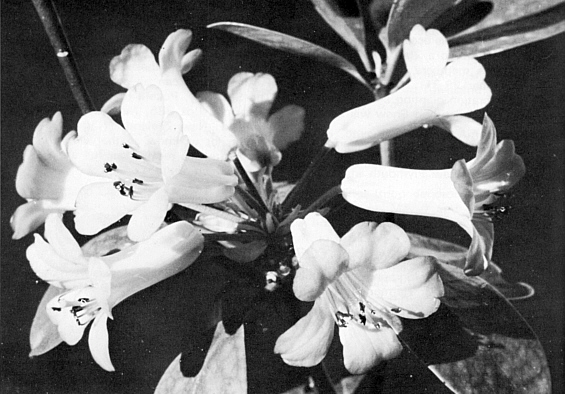
|
|
R. christianae
, the first Malesian rhododendron
introduced to Australia. Photo by Arthur Headlam |
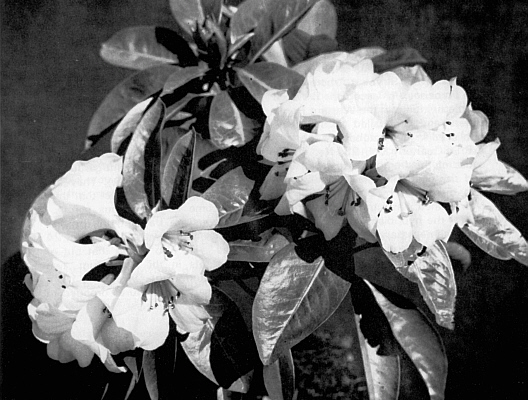
|
|
R. javanicum
, another Malesian rhododendron
growing vigorously in a tree fern log. Photo by Arthur Headlam |
The first Malesian rhododendron introduced to Australia was R. christianae , the seed of which was sent to the Australian Rhododendron Society in 1959 by Rev. Canon N. E. G. Cruttwell, and seed was germinated and plants distributed to members in 1961. There was considerable excitement when the first plant flowered in summer 1963, and hybridists were soon at work and the cross R. christianae x R. lochiae was made. Later, seed of R. konori , arfakianum , inconspicuum , macgregoriae , zoelleri and phaeopeplum was received from Dr. H. Sleumer and from then onwards a steady stream of seed and plant material has come forward.
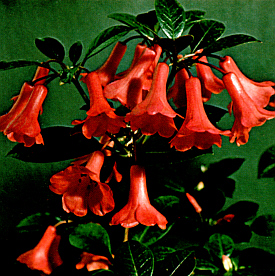
|
|
R. lochiae
Photo by A. W. Headlam |
Some brief notes on the discovery of
R. lochiae
, the only rhododendron indigenous to Australia, may be of interest:
In 1855 an expedition was led by A. C. Gregory in search of Ludwig Leichardt, an explorer, who with a party of seven had attempted to cross the continent from east to west. Their fate remains one of the mysteries of Australian exploration. Gregory had as a botanist Baron Ferdinand von Mueller, who had been appointed to the position of Victoria's first Government Botanist. On seeing the mist shrouded outline of North Queensland's coastal ranges, he speculated whether rhododendron and other plant forms characteristic of the cool Malayan sylvan regions would be discovered thereon, but it was not until 1887 that Sayer and Davidson climbed Mount Bellenden-Ker, altitude 5,200 feet, and in fact found a species of rhododendron which was named after Lady Loch, wife of the Governor of Victoria, in recognition of the patronage given by her Ladyship to Victorian horticulture.
R. lochiae
was given its first introduction to the general public at Garden Week in 1949, an annual display by nurserymen of a wide range of plants and gardening equipment. The fine specimen exhibited created considerable interest, although it had been known to and grown by the more enthusiastic gardeners for some years.
More and more members became interested in Malesian rhododendrons and as the plants developed many different growing media were used, peat moss, peat moss and sand and mixtures containing sphagnum moss, perlite and even some with a percentage of soil. The best results seemed to be obtained with a very open mix which was conducive to excellent drainage. And many types of containers were used, earthenware pots, plastic pots and plastic type basket containers, all with varying degrees of success. However, an enthusiastic grower and member of the Australian Rhododendron Society, Brian Clancy, has found that pieces of tree fern log some 12-15 inches long by 8-12 inches in diameter have given consistently good results.
Fern logs of smaller diameter, say up to six inches, do not have such a thick layer of fiber and are therefore not as satisfactory as the larger diameters of 8-12 inches. Logs of over 12 inches in diameter may be split lengthwise down the middle, thus obtaining two satisfactory sections with a thick outside layer of fiber. Pieces of fern log, which are usually fairly spongy, may be immersed in a container of water for as long as half an hour. When removed they will drain quickly, but do not entirely dry out.
At first, users made the mistake of hollowing out an area of the fern log and filling the cavity with one of the previously mentioned 'mixes', but, a well known fact with Asian rhododendrons is that the roots are extremely reluctant to leave the mixture in which they have been grown and spread into a different soil. With Malesians planted in a hollowed out fern log, the same principle applied. After 12-18 months they could be lifted out of the cavity when it would be obvious that the roots had not made any attempt to penetrate into the tough fern fiber.
After considering how some Malesian rhododendrons grow as epiphytes on the thick moss on tree trunks in the forest, Brian Clancy developed the idea of making an incision in the side of a fern log with a carpenter's chisel and planting the Malesian bare-rooted, direct into the fiber, without any additional mix whatever.
This can only be done with reasonably small plants, about one year old being the most satisfactory size. If the cavity is inclined to remain open, it is squeezed together and held with a U shaped wire staple of appropriate size. Once established, the roots of the Malesians, many of which have epiphytic tendencies, soon make their way into the fern fiber, start into a vigorous growth and never seem to look back. Admittedly, fern logs are somewhat hard to come by; like many other indigenous trees and shrubs, they are strictly protected in National Parks and other areas, and may only be obtained from private properties or occasionally when roadways and other works are under construction and ferns and undergrowth are removed to make way for roads and bridges, etc.
It is surprising how a large plant can thrive so successfully in such a comparatively small anchorage, but fertilization with a foliar spray and at the same time giving the fern log a liberal wetting seems to produce entirely satisfactory results. Some of the
R. lochiae
hybrids in the glasshouse in the National Rhododendron Garden at Olinda now measure up to four feet high by three feet across.
The Filicanae (Ferns) contain a vast number of genera and species, the taller ones for the purpose previously described being Cyatheacea and Dicksoniaceae, which grow best in localities subject to mists, fogs and rain. The trunks of these trees have a central core of wood and have no cambium layer - the material of which the trunk is formed is fibrous and tough and they produce leaves and fronds forming a spreading crown. The fibrous trunks provide a home for many epiphytes, a twenty foot high tree fern in the National Garden at Olinda has a large Acacia growing high up out of its trunk, the seed presumably having been blown by the wind or carried by birds. There are also a number of epiphytic creepers growing amongst the fronds forming the spreading crown. Eventually, the Acacia will crash to the ground as it continues to get larger and larger and is torn from its precarious anchorage by a strong gust of wind.
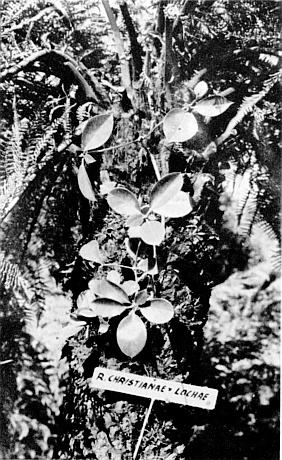
|
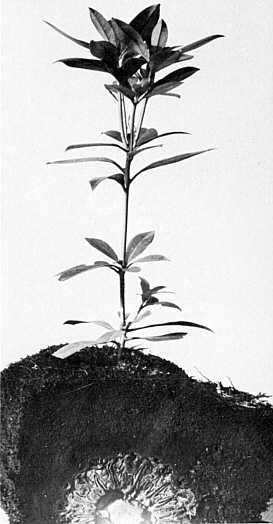
|
|
'Pink Delight' growing vigorously
in the fiber of a tree fern log. Note the central core of hard wood surrounded by a thick layer of fern fiber. Photo by Arthur Headlam |
A plant of
R. christianae
x
R. lochiae F2, artificially planted as an epiphyte on the trunk of a living tree fern in the National Rhododendron Garden at Olinda. Photo by Arthur Headlam |